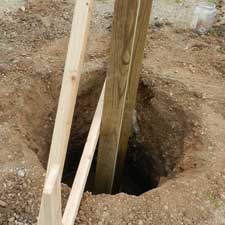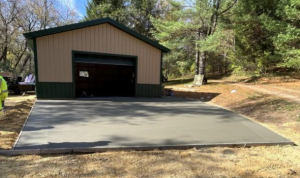Part of being able to determine a budget for a new pole building is the cost of the premix concrete needed to backfill the holes with.
 At Hansen Pole Buildings, our engineers calculate the minimum amount of post hole concrete required to prevent your new building from settling (due to the dead weight of the building, as well as when carrying applicable roof loads), as well as from uplifting or overturning.
At Hansen Pole Buildings, our engineers calculate the minimum amount of post hole concrete required to prevent your new building from settling (due to the dead weight of the building, as well as when carrying applicable roof loads), as well as from uplifting or overturning.
In most cases the lower hole portion only (usually about 1/2 to 2/3) will be filled with pre-mix concrete. This is known as a concrete collar. (Read more about concrete collars at https://www.hansenpolebuildings.com/blog/2012/02/concrete-collars/)
The design is done so the footing (concrete below the column) and the collar can be poured all at one time. Usually the total depth of the concrete required is 18 inches.
Determine concrete volume required:
Multiply ½ hole diameter (in feet) squared, x 3.14 x concrete collar depth (in feet) times hole number, divided by 27.
Like math in high school? This is what formula looks like:
(½ X hole diameter)² X 3.14 x concrete collar depth X # of holes
27
Although it depends upon many factors (such as soil bearing capacity, actual building dimensions and applied loads), the majority of buildings require only 18” diameter holes.
Let’s take a peek at a 36’ x 48’ building, which would typically have around 14 holes (number may be more depending upon positioning of doors).
Inserting the variables into the formula:
(½ X 1.5’)² X 3.14 x 1.5’ X 14
27
The result is 1.37 cubic yards. Even if the holes were all two feet in diameter – 2.44 cubic yards. Not much concrete, but still part of the total budget to be factored in.
But, the pole itself is taking up a portion of the upper 10 inches, why not deduct for it?
The answer is pretty straightforward – it is pretty challenging to get an exactly round and perfect hole! If all of the columns in the example above were 6×6, the volume of them is only 2.45 cubic feet (or under 1/10th of a yard).
Of course more concrete can be placed in the hole. However a caution – do not overfill any holes with concrete! Excess concrete may interfere with later skirt board installation. Doubly important, for animal safety (especially in equestrian facilities), is to have post hole concrete end below grade level. Native soil can fill in the top 2-3 inches for a level grade surface.
 In a hurry? Choose Sakrete® Fast Setting Concrete Mix. This product combines the convenience of high strength concrete mix with a set time of just 30 minutes. Simply pour the product in the hole, add water and install posts. Since this is a fast setting concrete mix, a pole building can be framed the same day posts are installed.
In a hurry? Choose Sakrete® Fast Setting Concrete Mix. This product combines the convenience of high strength concrete mix with a set time of just 30 minutes. Simply pour the product in the hole, add water and install posts. Since this is a fast setting concrete mix, a pole building can be framed the same day posts are installed.





